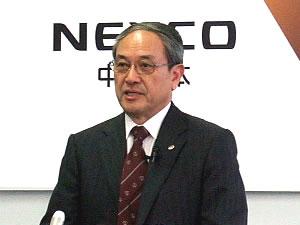2008年04月16日東海北陸道の開通に関する記者会見
会見要旨
(司会)
ただいまから、東海北陸自動車道の開通に関して、会長から説明させていただきます。
(会長)
 みなさんこんにちは。臨時のご説明の場でということで、早速お集まりいただき、ありがとうございます。
みなさんこんにちは。臨時のご説明の場でということで、早速お集まりいただき、ありがとうございます。
東海北陸自動車道の飛騨清見ICから白川郷ICは、工事を続けていますが、本年の7月5日に開通するということに決定しました。
もともと、3月末に開通する予定でしたが、11月1日のこの記者会見の場で説明したような事情で、安全を第一に考えて、延期したわけですが、7月ごろとご説明していましたが、工事はその後順調に進展していまして、7月5日に開通となりました。
3ヵ月あまり開通期間を延期しまして、色々、ご関係の皆様にご迷惑をおかけしまして、改めてお詫び申し上げたいと思います。
それから、開通後、10月いっぱいの予定で、期間限定ですが、東海北陸道全線開通割引というものを実施します。
お手元の資料にありますような内容でして、ちょっとそれをご覧いただきたいと思います。
開通日時は7月5日土曜日15時、開通区間は今申し上げたところで、24.9kmです。開通区間の概要、諸元や施設名はここに書いてあるとおりです。開通区間の特徴としては、構造物の大変多い、全体で89%という構造物比率、文字通りの山岳をトンネルでくりぬき、橋でわたるという道路を造ってきたわけで、特に飛騨トンネルについては、着工から開通まで9年半を要しました。最初のこの全体の区間の施行命令を受けた時点から言いますと15年の歳月を経て、ようやく開通の運びとなったということです。
何よりも安全に通行していただくための諸設備の設置をやっているところです。3月には舗装が終わりまして、今、逐次設備を設置しているところで、出来上がった施設はそれぞれチェックしていますが、5月に入りますと、全体のシステム点検をして、一層安全の確認ができるという運びになっています。
開通区間については、なんと言っても大きなネットワークがこれによって出来上がるわけで、経済や産業だけでなく、観光、生活や救急医療などいろんな面で、経済、社会全般にわたって、皆様方のご期待に応えることのできる道路になると確信しています。
なお、この開通にあわせまして、飛騨河合PAにスマートICを供用する予定です。
記念割引の内容ですが、先ほど申しあげたように10月31日までの間で、半額割引を考えています。この開通割引終了後も、ご利用の実態などを踏まえまして、2008年度内という条件付きですが、なんらかの割引を検討したい、状況を見て決めていきたいと考えています。
詳しい割引の内訳は次のページに書かれていまして、ETCの有無にかかわらず割引、全車種を対象にし、エリア限定というのが今回の特徴だと思いますが、後のページでご説明します。
また、当日の開通式典につきましては改めてご連絡申し上げます。ぜひ、多くの皆様にご参加いただければ、大変ありがたいと思います。
別紙1が通行料金、通常料金です。別紙2が対象エリアで、南は岡崎ICから始まって、東海環状、中央道、東名、名神、東海北陸道と北上して、東は朝日IC、西は金沢ICですが、金沢西IC、金沢東ICについては、この※印に書いてあるような取り扱いをさせていただくようになっています。次のページが割引適用後の料金になります。
次のページが位置図と詳細図です。東海北陸自動車道は全長185km、今回の工事区間は24.9kmです。その次が飛騨清見ICと白川橋の写真を添付しています。白川郷は文化遺産ということを考えて、橋の構造、色、高さなどを配慮して設計がなされています。
次のページから別紙3で、なんといっても東海地方と北陸地方が近くなります。大型で約35分、距離が約65km短縮されます。次に一般道の代替機能を発揮するということがありますが、これまでも災害時に一般道が通行不能になり、その間、高速道路が役割を果たしてきていますが、今回、その役割が一層強化されるということです。②-2として、ネットワークが完成するということで、北陸自動車道ルート、東海北陸自動車道ルート、中央道から上信越ルートと大きなネットワークが完成して、信頼性が高まるということです。
次が救急医療体制です。白川郷には大病院が無くて、高山の赤十字病院を使うことが必要になってくるのですが、現在85分かかるところが、40分ですむということです。
次が大気環境が改善されるという、地球環境への貢献です。
⑤が北陸地方の企業立地を推進しますということで、ここにありますように、ずいぶんいろんな計画が進行していて、これは当然、道路というものが出来上がることが大きな契機になっていると思います。
次が広域観光ですが、この中部地方は観光資源の豊富なところで、道路ネットワークによって、国内のお客様はもちろんですが、海外のお客様も期待できると思っています。次が同じように、富山や飛騨地方の発展ということで、ご覧いただきたいと思います。
生活圏域が拡大するということで、高山あるいは白川からの2時間圏を示してありますが、本当に大きな変化がここでもたらされると思います。
それから自治体間の連携ということで、都市間交流がいろんなところで協定が結ばれたりして進んでいますが、その機能を一層強めることが期待できます。実際、私どもの道路を利用されているお客様にアンケート調査や対面調査をしたのですが、この資料にありますように、ぜひ利用したいという方が多くて、その理由は移動時間の短縮とか、観光地などの活用といったことが高い率を占めています。
環日本海経済圏での国際競争力の強化ということで、富山の伏木富山港のデータを載せておきました。また、通勤、通学の支援ですとか、沿線自治体の雇用の促進といったことが触れられています。
ゆっくりご説明できませんでしたけれども、以上のような資料をご参照いただき、今回の開通についてのご理解を深めていただければ、大変ありがたいと思います。
以上で、最初の説明を終わります。
(司会)
では、ご質問がありましたらよろしくお願いします。
(記者)
今回の開通区間の総事業費は1,860億円とのことですが、一宮JCTから小矢部砺波JCTまでの185kmの総事業費はいくらでしょうか。
(会長)
今手元に資料がありませんので、この会見が終わるまでにお知らせします。
(記者)
申し訳ありませんが、この区間の開通が遅れていた理由を改めてお聞かせください。
(会長)
飛騨トンネルが非常に難しい地盤で、歴史に残る難工事でした。これが大きな理由です。水がたくさん出たりして、貫通に至るまでも相当の時間を要したんですけれども、貫通後も地山が変状したりということが続きまして、そのたびに新しい工事が増えました。これにより時間がかかった、ということです。飛騨トンネルは籾糠山という山の下を通っています。標高は1,744mなんですが、トンネルが通っているところから上の土かぶりが1,000mあるんですね。このような工事は例がなく、これまでに周辺でトンネルが掘られたこともなかったため、地質調査を熱心に行ったにもかかわらず、工事が始まってみると難工事となりそうなことが分かり、慎重には慎重を期して安全第一を念頭に置いて、開通の日延べをした、ということでした。この区間にトンネルは10あって、そのうち最も長いのが飛騨トンネルで10.7kmあるんですが、残りの9本はだいぶ前に完成していまして、全体チェックも進んでいます。飛騨トンネルがたいへんだった、ということです。
(記者)
開通が遅れるというアナウンスの際の会見で、総事業費や収入に影響が出る、具体的には料金収入が約5億円減る一方で管理費が3億円ぐらい少なくて済み、差額でマイナス2億円程度とのことでしたが、最終的にはどのようになっているでしょうか。
(会長)
詳しく精査した結果、総事業費が10億円少々オーバーすることが分かりました。それから供用後の収入と費用の比については、先日は5:3と申し上げましたが、3:2で1億円のマイナスです。3ヵ月開通が遅れましたので、その分3億円の収入減、そして費用が2億円出ずに済みましたから、実質マイナスが1億ということですね。これが現時点で把握している数字です。
(記者)
10億円増えて総事業費が1,860億円になった、ということですね。
(会長)
今機構と協定を結んでいる金額が773億円あるんですね。それが10億円と少しオーバーして786億となるということです。
(記者)
橋げたに使用するポリエチレンシースのデータが偽装されていたという問題がありましたが、これに関して東海北陸自動車道でもそのシースが用いられていたようです。一時工事を中断してその後再開したということだったと思います。改めて会長から安全性への影響についてと、飛騨トンネルに関しても工事が遅れたということがありますが、あわせてお聞かせいただけますか。
(会長)
安全性については万全を期してチェックをし、大丈夫だという判断をしています。橋げたについても、飛騨トンネルについてもです。
(記者)
シースの偽装についても、工事への影響は出ていないということでよろしいでしょうか。
(会長)
そうですね。大丈夫です。何か補足はありますか。
(部長)
シースの件に関する補足ですが、飛騨清見~白川郷間には対象の橋梁はありません。東海北陸道では4車線化中の区間で、対象となる橋梁がありました。
(記者)
関係の行政各自治体の首長さんらへのご報告やご説明はどういったスケジュールで予定されていますか。それとも既に終えておられるのでしょうか。
(会長)
昨日から今朝にかけてお話をさせていただきました。以前延期をさせていただく際には、すみずみまで皆で手分けして伺ったんですが、このたびは開通に関する内容で、すでに7月頃という予告もさせていただいていましたので、本当に関係の深い所にだけご説明にあがりました。
(記者)
もし差し支えなければ、どちらかもお教えいただけませんか。
(会長)
まず岐阜と富山の両県知事ですね。そして地元の市町村です。飛騨市と白川村ですね。
(記者)
どのような反応だったでしょうか。
(会長)
7月頃ということを予告していましたので、その月でも前のほうで開通できたという点はご理解いただけたと思います。皆さん地元の方ほどこの工事がたいへんだったということをよくご存知でして、そういった地元のご理解があったので今日までやってこれたんだな、と改めて思いました。
(記者)
今おっしゃった自治体は足を運ばれてお話になったということですか。
(会長)
当社の地元の出先の者が伺ってお話させていただいた、ということですね。私自身は特に動かずに。いいお話ですので、誰が伺ってもいいと思うんですね。悪い話のときは私自身率先して伺いましたけれども。正直なところを申し上げるとそんなところです。
(記者)
あと経済団体はいかがでしょうか。
(会長)
経済団体については2つの経済団体ですね、中部経済連合会と北陸経済連合会それぞれに。実はまだ両会長にはまだ電話連絡がついていないので、この会見が終わった時点でご連絡しようと思っています。
(記者)
南北を貫く道路がいよいよ全線開通するということで、改めて会長の率直な感想、気持ちをお聞かせください。
(会長)
この区間の施行命令以来15年。最もたいへんだった飛騨トンネルで10年の歳月をかけてやってきた。東海地方と北陸地方という2つの経済社会圏を結ぶこの道路に対する強い期待があったからこそ、ここまでこれたと思いますし、心から感謝しております。このネットワークの完成で、経済、社会の両面でお役に立つことができれば、これほどうれしいことはありません。
(記者)
名古屋市内では高速道路が雪によって通行止めになることが多いんですけれども、この区間は豪雪地帯ということで、この地区にとって通常の雪であれば、通行ができるような備えになっていると理解してよろしいんでしょうか。
(会長)
ええ。一つは融雪設備ですね。トンネルが10本連なっている中に橋があるという区間ですので、表に出た所では雪を溶かす設備を常設しています。また、山に積もった雪が道路内に崩れてくるといけませんので、雪止め対策をきちっとするとか、そうした点に配慮してなるべく通行止めが発生しないよう手を打っています。
(記者)
そうすると通常の冬場の雪であれば、完全に通れる、名古屋市内は通行止めでもこちらは走れる状況もあり得る、ということでしょうか。
(会長)
「完全に」と言われると自信がないんですけれども、そうした場合もあり得ると思いますね。やはり雪に慣れている地域と慣れていない地域とではずいぶんと違いますよね。飛騨地方を通る車はチェーンを装着するなどの配慮を最初からされている場合が多いので、そういう意味ではかなり効果が上がってくるのではないかと思います。しかし通行止めをしなくてもいいか、ということについては、最善の努力はしますけれども、そのとおり行くかどうかはやってみなければわかりませんね。
(記者)
資料に飛騨地方や北陸地方にとってのメリットがあるんですけれども、東海地方や名古屋にとってのメリットというものはいかがでしょうか。
(会長)
一つ経済面からいうとやはり産業立地でしょうね。名古屋は人手不足のもっともたいへんな地域だと思うんですね。この地域で工場をつくろうとしましても、簡単に人が集まらないというのが実態だと思います。そうした点では道路でつながった他の地域で工場立地が進むのは、名古屋圏にとって大きなメリットだと思います。
(記者)
北陸の方で工場立地が進むことで、名古屋の人手不足が緩和できるということでしょうか。
(会長)
そうですね。
(記者)
昨今道路特定財源の議論の中で、道路の必要度、優先度に関する議論が出ていますけれども、会長はこの東海北陸道の必要度についてはどのように認識されていますか。少々いじわるな質問かもしれませんが。
(会長)
いえいえ。たいへんありがたいご質問です。東海北陸道は第一級に必要度の高い道路だと私は信じています。まず何といっても今申し上げたような産業、経済を活性化するという点ですね。北陸経済連合会の調査では少々古いんですが、年間の経済効果が7,300億円ということなんですね。ただ比較対象が平成11年ですから少々古いんですけれども。それが一つ。それから観光ですね。私は期待しているんですが、これからは国内の観光だけでなく、外国人観光客が増えていくだろうと思います。「Visit Japan」で2010年に1,000万人という計画があります。もともと500万人くらいだったのを倍増しようという計画で、いま850万人くらいまで来ているんですね。まだものすごい変化が足元で生じているかといえばそれほどでもないんですが、今後2,000万人とか3,000万人と外国人観光客が増えれば、観光資源の宝庫である中部地方では、中部国際空港で降りて、ぐるっと回って関空へ向かう人や、富士山に行く人が、バスやレンタカーを利用するようになる。そういったことを考えると、まだわれわれも道路の案内などまだまだ不十分なところは多いんですが、長期的なことを考えて準備しようということで、新しく英文の道路地図を最近発行したり、英文のWEBページを用意したり、韓国語や中国語標記の標識を検討したりと、さまざまなことを行っていこうと考えています。そういったことをやっていくことで、大きな効果が生まれる。また資料中にもありますが、リダンダンシーということで、大災害時の代替路としての意義というものも非常に大きいと考えています。
(記者)
名古屋と北陸の立地の件でおしゃっていましたが、北陸道と比べると大型貨物車で35分、乗用車では15分の短縮しかありませんが、それでも工場立地は変わるものですか。2時間3時間の短縮ならわかりますが。
(会長)
確かにそのような面はありますが、代替路として片方の道路が大事故などで閉鎖された場合に代わりがあるということが大事なんです。私は、企業の経営者にとってはすごく大事なことだと思います。新潟の地震で大変な時がありましたが、少し遠回りであっても道があったからこそ、ある程度カバーできたと思います。今度の場合も資料にも入れましたが、北陸道があって、東海北陸道があって、中央道・上信越道あるというようにネットワークができてくると、いざというときの安心感は非常に大きいと思います。それと定時性ということで、ある程度予測できる時間で人や物が動けるということが大事です。時間が1時間短くなることも大事ですが、きちんと予測できる時間で移動ができるということは、例えば製造業であれば、生産計画をそういう時間の中でつくればいいわけですから、非常に効果が大きいであろうと思います。
(記者)
全通することによって交通量はどういうふうに変化するのかと、いま北陸道を経由して富山に向かっているものが振り向けられる交通量の変化をどのように見ていますか。
(会長)
今度開通する区間の日断面交通量は3,000台くらいと見ています。しばらく経って5,500台くらいになっていくだろうと思っています。冬にどういう交通量になるかは少し控えめに考える必要がありますが、夏の観光時期では、7月に学校が夏休みになりますし、10月末まで割引としたのは観光シーズンということもあってのことなのですが、ここでどれだけ交通量があるのかが我々の最大の関心事です。これは開いてみないと判らないというところです。先だって開通した新名神も、当初は14,000~15,000台と言っていたものが、28,000台くらいの交通量があり、現名神から移っている車が14,000台とか言われるように、大雑把に言いますと予測していたよりも大体倍くらいになっています。是非この東海北陸道もそうあって欲しいと思います。実際にやってみてきちんと実態を把握したいと思っています。
(記者)
料金設定のことでお伺いしたいのですが、新しく開通する白川郷ICから飛騨清見IC間が普通車ですと1,200円と設定されていますが、これは通常の料金なのか、若干高めに設定されているのかを教えてください。
(会長)
飛騨特別区間という料金設定になっておりまして、普通の道路より少し高い値段設定となっています。これが通常料金です。
(記者)
高く設定された理由はどのようなところにあるのでしょうか。
(会長)
トンネル工事の大変さとか、そうして実際にかかった経費の大きさとか。機構に長い年月をかけて返済していくわけです。そこで決められた基準があって、それに従って通常料金の設定をしているわけです。そういう事情で高くなっています。
(記者)
飛騨清見IC~白川郷IC間の距離ですと、特別料金でない場合だとどれくらいになるのでしょうか。
(会長)
この料金表をご覧いただくと普通車で1,200円です。機構との協定で決められている飛騨特別区間の料金は、通常料金の1.6倍くらいです。
(会長)
先ほどの質問のデータはわかりましたか。185kmの総工事費についての質問がありましたね。
(部長)
ご質問のあった一宮JCT~小矢部砺波JCT間、185kmの総事業費は、約1兆2,200億円です。
(記者)
9ページの料金のことで確認したいのですが、一宮JCT~小矢部砺波JCTまで、名神・北陸道を経由した249kmと東海北陸道を経由した185kmの料金の違いはいくらになりますか。
(会長)
6千円ちょっとが5千いくらになるかといったところですが、わかる人説明してください。
(チームリーダー)
実際のご利用の場合はJCTではなくICからとなりますので、一番近い例で申しますと、一宮IC~富山ICまでのご利用ですと、これまでの北陸道経由の料金ですが、6,200円でした。今回東海北陸道が全通することによりまして、この料金が5,350円になります。ちなみに料金の算定ルールとしましては、お客様が最短、最安のルートを使った前提での料金計算を行いますのでどちらのルートをお使いになっても5,350円になります。
(記者)
7月に全線開通ということですが、まだ暫定2車線で供用している区間もあって4車線化もひとつこれからの課題ではないかと思いますが、そのあたりはどうお考えでしょうか。
(会長)
私どもにとって将来の非常に大事な課題だと思っています。それを実現るすには、いろいろな関係者の賛成を得なければなりませんので、これは先のことではありますが、これは課題として十分考えています。ご承知のとおり、いま瓢ヶ岳~白鳥まで4車線化を進めておりまして、本年度から来年度にかけて順次開通していきます。白鳥から先をどうするかが残された課題でありまして、これについては何とか実現できるように私どもも努力したいと思います。当社だけの判断でできることではございませんので、これからの課題と思っています。
(司会)
本日の記者会見はこれにて終了させていただきます。本日はどうもありがとうございました。
(会長)
どうもありがとうございました。

